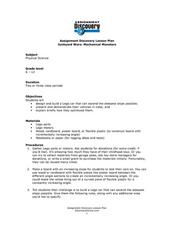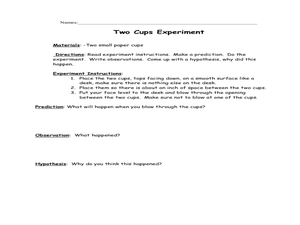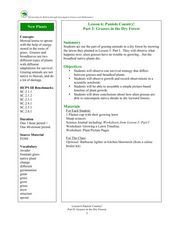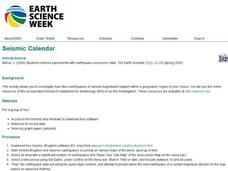Curated OER
A Mini Insect Field Trip
Students practice the four skills they have already explored so far: collecting, labeling, pinning, and making field observations on insects and plants in the RHS Outdoor Science Classroom.
Curated OER
Mechanical Monsters
Students experiment try to build a Lego car. In this physical science lesson students present and demonstrate the vehicle that they constructed.
Curated OER
Galapagos Islands
Students study the science and geography related to the Galapagos Islands. In this ecosystem lesson, students locate the Galapagos Islands on a world map and discuss its significance in history. Students complete a vocabulary sheet,...
Curated OER
Understanding Bernoulli's Principle
Fifth graders explain why we fly. In this space science activity, 5th graders discuss Bernoulli's prinicple and its relation to flight.
Curated OER
Lesson 6: Paniolo Country Grazers in the Dry Forest
Learners explore grazing animals in a dry forest. For this science lesson, students act out the role of a grazer in the dry forest. Learners cut their growing lawn and observe what happens after being cut. Students explore differences...
Curated OER
Introduction to Earth's Dynamically Changing Climate
Learners identify the most common causes of global warming. In this earth science lesson, students use an interactive website to explore changes over time in sea ice, sea level, carbon emissions, and average global temperature. They take...
Curated OER
Peppered Moth Simulation Activity
Students simulate peppered moth predators using SmartNotebook. In this life science instructional activity, students collect survival data and analyze results. They explain the importance of changes in species over time.
Curated OER
Air Pollution: Visible and Invisible
Fourth graders work together to complete an experiment on air pollution. They identify visible and invisible forms of pollution. They gather their data in notebooks and analyze their results to end the lesson.
Curated OER
Diseases
Sixth graders create a type of notebook or journal using colored copy paper on which to take notes. They complete research on a certain disease and report on it and then design their own disease causing bacteria or virus. Finally, 6th...
Curated OER
Rock Abrasion
Students discover how abrasion works on rocks. In this science activity, students experiment by showing how abrasion works by using sugar cubes.
Curated OER
Seismic Calendar
Students discover how often earthquakes happen in a region of their choice. In this science lesson, students use online resouces to help them do their investigations. Students make their own map of their region and show how many...
Curated OER
Limu in Your Lunch
Students explore various types of algae found in Hawaii. In this science lesson, students research species of the three types of limu and identify various uses. Students explore products that contain limu.
Curated OER
Hatching Chickens
Students observe chickens hatching in a classroom incubation environment In this egg-hatching lesson plan, students make observations of the hatching process and later care for the hatched chickens.
Curated OER
Tracks and Trails-Nature Notebook
In this nature worksheet, students find some trails in their neighborhood and complete a graphic organizer, drawing pictures, guessing who made the trail and why and following it to see where it begins and ends.
Curated OER
Mushroom Hunt-Nature Notebook
In this mushroom hunt worksheet, students hunt for mushrooms, then sketch some mushrooms or paste photos and write notes about each one. A reference web site is given for additional activities.
Curated OER
Science: Liquid Matter
Second graders examine the properties of liquids and their classifications. They compare and contrast cups of different liquids and record their findings in journals. Students observe how liquids flow at various speeds and that unlike...
Curated OER
Nocturnal Animals Cloze Activity
In this science cloze activity, 3rd graders fill in the 9 blanks in a selection about nocturnal animals. They use the words from a word bank at the bottom of the page to complete the paragraph. They cut out pictures of nocturnal animals...
Curated OER
Kitchen Chemistry
Fifth graders examine both physical and chemical changes, and how to identify the difference between the two. They observe the changes that occur in butter when it is exposed to heat and cold, heat energy. In their notebooks, they write...
Curated OER
Native Plant Species Web Quest
Students visit USDA Plants Database Web site at
http://plants.usda.gov/ to identify native species of the Southern
Appalachian Region. They name and describe each species in general
terms in their field notebooks for the purpose of plant...
Curated OER
Nocturnal Animals
In this animal worksheet, students complete a cloze activity about nocturnal animals by filling in the blanks in 2 paragraphs using 9 words from a word bank. They color and cut out 13 small pictures of nocturnal animals and paste them in...
Curated OER
Urban Life: What Lives in Our Schoolyard?
Learners research living organisms by exploring their school grounds. In this microscopic observation lesson, students gather materials, insects, and objects from their playground and schoolyard and bring them into class. Learners...
Curated OER
Botanical Garden Field Trip
Young scholars take a field trip to a botanical garden. For this habitat lesson, students walk through the garden and see various species of plants and animals. Young scholars take a canopy walk and see coniferous trees. Students write...
Curated OER
Preparing for the New Haven Public School Science Fair Through Environmental Science
Learners discover what type of effect that pesticides have on earthworms. They use three different types of pesticide and examine the external and internal effects that each have on earthworms. They maintain earthworms in habitats...
Curated OER
Math and Science in a Wetland
Students use scientific methods during field and lab investigations. Students collect specimens and make measurements using the metric system. Students describe biotic and abiotic factors in an estuary and design a model.

























